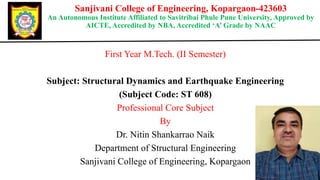
Earthquake Engineering.pptx
- 1. Sanjivani College of Engineering, Kopargaon-423603 An Autonomous Institute Affiliated to Savitribai Phule Pune University, Approved by AICTE, Accredited by NBA, Accredited ‘A’ Grade by NAAC First Year M.Tech. (II Semester) Subject: Structural Dynamics and Earthquake Engineering (Subject Code: ST 608) Professional Core Subject By Dr. Nitin Shankarrao Naik Department of Structural Engineering Sanjivani College of Engineering, Kopargaon
- 2. • So far: • Interior of earth • Sources of Earthquake • Plate Tectonics • Rebound Theory
- 3. faults…… • Fracture between the two rock masses is termed as fault and it’s extent is the surface along which movement occurred. Most of the faults are at the ocean depths. Movement at a fault can be either in a horizontal or in a vertical direction or both. • The horizontal line interface relative to the north between the fault plane and the horizontal plane is called it’s strike. • The angle between these planes is called it’s dip.
- 4. Types of faults… • There are two types of faults a) Strike Slip Fault and b) Dip-Slip Fault • Strike Slip Fault: • This type of fault occurs when movement is parallel to the strike. Usually the fault plane is nearly vertical and the plate surface on one side of the fault slides horizontally past the other. If the block opposite an observer looking across a fault moves to the right, it is termed as right lateral ( See Figure a) , and if the block moves to the left, it is called as left lateral.(See Figure b)
- 5. • Dip-Slip Fault: This type of fault occurs when rock on either side of a fault slip relative to each other along an inclined plane. If the rock mass above an inclined fault moves down, it is termed as normal fault otherwise reverse fault.
- 6. Seismic waves…. • What are the seismic waves? • Seismic waves are the waves of energy caused by the sudden breaking of rock within the earth or an explosion. They are the energy that travels through the earth and is recorded on seismographs. • Types of Seismic Waves There are several different kinds of seismic waves, and they all move in different ways. The two main types of waves are body waves and surface waves. Body waves can travel through the earth's inner layers, but surface waves can only move along the surface of the planet like ripples on water. Earthquakes radiate seismic energy as both body and surface waves.
- 7. Body waves……… • Traveling through the interior of the earth, body waves arrive before the surface waves emitted by an earthquake. These waves are of a higher frequency than surface waves. • There are two types of body waves: 1) P waves and 2) S waves • P WAVES: (Primary Wave or Compressional Waves) The first kind of body wave is the P wave or primary wave. This is the fastest kind of seismic wave, and, consequently, the first to 'arrive' at a seismic station. The P wave can move through solid rock and fluids, like water or the liquid layers of the earth. It pushes and pulls the rock it moves through. P waves are also known as compressional waves, because of the pushing and pulling they do. Subjected to a P wave, particles move in the same direction that the wave is moving in, which is the direction that the energy is traveling in, and is sometimes called the 'direction of wave propagation'.
- 8. This is the fastest kind of seismic wave, and, consequently, the first to 'arrive' at a seismic station. The P wave can move through solid rock and fluids, like water or the liquid layers of the earth. It pushes and pulls the rock it moves through. P waves are also known as compressional waves, because of the pushing and pulling they do.
- 9. • S WAVES: The second type of body wave is the S wave or secondary wave, which is the second wave you feel in an earthquake. An S wave is slower than a P wave and can only move through solid rock, not through any liquid medium. S waves move rock particles up and down, or side-to-side-- perpendicular to the direction that the wave is traveling in (the direction of wave propagation).
- 10. Surface waves…. Travelling only through the crust, surface waves are of a lower frequency than body waves, and are easily distinguished on a seismogram as a result. Though they arrive after body waves, it is surface waves that are almost entirely responsible for the damage and destruction associated with earthquakes. Types of Surface Waves: there are two types of surface waves 1) Love Waves 2) Rayleigh’s wave • Love Waves: The first kind of surface wave is called a Love wave, named after A.E.H. Love, a British mathematician who worked out the mathematical model for this kind of wave in 1911. It's the fastest surface wave and moves the ground from side-to-side. Confined to the surface of the crust, Love waves produce entirely horizontal motion.
- 11. It's the fastest surface wave and moves the ground from side-to-side. Confined to the surface of the crust, Love waves produce entirely horizontal motion.
- 12. • RAYLEIGH WAVES The other kind of surface wave is the Rayleigh wave, named for John William Strutt, Lord Rayleigh, who mathematically predicted the existence of this kind of wave in 1885. A Rayleigh wave rolls along the ground just like a wave rolls across a lake or an ocean. Because it rolls, it moves the ground up and down, and side-to-side in the same direction that the wave is moving. Most of the shaking felt from an earthquake is due to the Rayleigh wave, which can be much larger than the other waves.